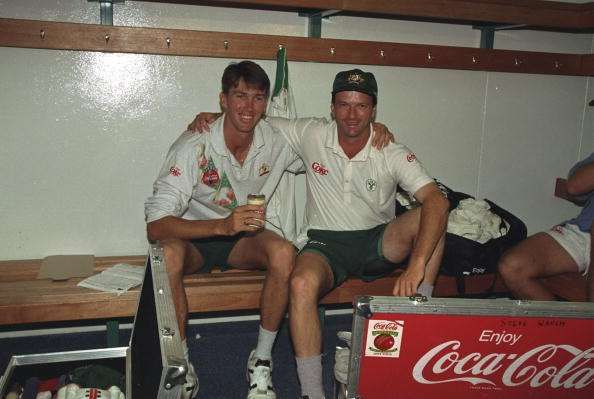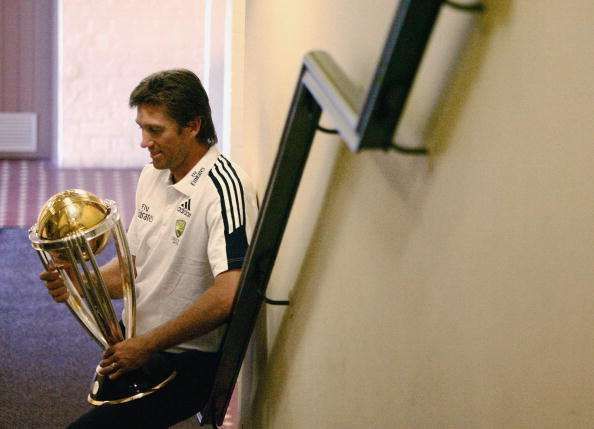
Glenn McGrath - The story of the boy who couldn't bowl

The boy who couldn’t bowl
He was the boy who couldn’t bowl. Too thin, too tall, he was dismissed as possessing no more talent than a broomstick. His fellows in the New South Wales outback never expected much of him, let alone becoming one of the greatest fast bowlers to grace the game of cricket.
They said his bowling was erratic, he was painfully thin to take a fast bowler’s burden, and even Dennis Lillee did not mark him as special when Lillee first saw him bowl.
Also Read: Greatest Australian ODI XI of all time
Yet, the sixteen-year-old knew what he wanted. He wanted to play for Australia, and demolish the West Indian team that was tormenting the Baggy Greens. So he trained silently each day, bowling against a 44-gallon drum, after a hard day’s work at the field, perfecting his line and length.
Doug Walters spotted him, and he moved to Sydney, living in an old caravan, often eating only one Mars bar for dinner because it was all he could afford.
This was the making of Glenn McGrath, the man who would go on to torment batsmen around the world not with fiery pace, but with unerring, constant line and length.
The birth of a legend

In spite of his debut in 1993, it was only in the West Indies in 1994 that Glenn McGrath displayed his true prowess. The Windies had not lost a series since 1980. It had been over twenty years since Australia had won a series in the Caribbean.
It was here that Australia unleashed the players who would go on to dominate world cricket for over a decade. The Waugh brothers and Glenn McGrath. McGrath picked up 17 wickets, including those of Brian Lara and Richardson. From this series on, there was no turning back. McGrath went on to scale heights yet unaccomplished by any fast bowler. He became indispensable in the Australian dressing room, where he earned the nickname ‘Pigeon’, for his long legs.
His strength was in his unerring accuracy and his 6’5 height which allowed him to extract unpredictable bounce. He called himself ‘boring’, for he would bowl the same line and length till he outwitted the batsman. But his greatest strength was his will-power and his belief in himself. Never once did he have a nightmare about his bowling. He knew where he wanted to pitch the ball, and he almost always did.
The adrenaline sometimes got the worse of him. He sledged, played on the batsman’s mind, knowing that his mental foundation was strong enough to break most of them down. Only on a few occasions did it wear him down.
The woman of his dreams

In 1995, he met the woman who would be his pillar of strength and inspiration. Jane Steele was an English lass, who did not believe cricket was a sport to write home about. They met at a nightclub in Hong Kong, and as they say, sparks flew immediately. But it wasn’t a while into their relationship that Jane realised she was dating a cricketing superstar.
All was well until Jane was diagnosed with breast cancer in 1997. When she offered to leave McGrath and deal with it alone, he wouldn’t have any of it. He stuck by her through her treatment and they were married in 1999.
Seeing his wife struggle with cancer, he learnt to push his pain threshold to the limit. He bowled through torn ligaments and stomach cramps, getting his team the vital wickets.
His career, however, did experience injury threats. A torn ankle ligament forced him out of cricket in 2004. A freak injury in the nets during the 2005 Ashes led him to miss the rest of the series. Some say England won them only because of McGrath’s absence. He then missed a substantial amount of cricket to be with Jane who was diagnosed with cancer once again.
The end of an era

But Glenn McGrath’s determination was unbendable and he wrote his own swansong. He retired from Test cricket in 2006, winning the Ashes 5-0 and picking a wicket of his last ball, at his home ground, the SCG. He retired from the one-day internationals following the World Cup 2007, which Australia won and he was adjudged the Man-of-the-Tournament with 26 wickets.
Through this 14-year career, McGrath became the first Australian fast bowler to play 100 Tests. His 563 scalps are the highest number of Test wickets by a fast bowler. He is the highest wicket taker for Australia in ODIs with 381 wickets, while also holding the record for the most wickets in a World Cup (26 wickets in WC 2007).
Also Read: 5 Test bowlers with most top order wickets
But numbers do not tell the complete story of this man who defied all odds to become one of cricket’s most respected, revered players.
Behind the tough, determined look he always wore on the cricket field, there are stories of love and dedication that drove him. Glenn and Jane McGrath were perhaps the perfect embodiment of true love. Together, they strove to beat the insidious illness and waged a public battle against it by establishing The McGrath Foundation. Sadly, Jane passed away in 2008, leaving behind a beautiful legacy. Glenn McGrath still works relentlessly with the Foundation to keep this legacy alive.
And most of all, he has become an inspiration. An inspiration to fight till you win – someone who personified what determination meant. Someone who showed us that no dream is too big and no effort too small. That certain someone everyone needs in their life to make them believe that life can be magical if you work harder every minute of each day.
A champion of the game we love, he has inspired individuals in ways more than he will ever know.
So, for making us believe that anything is possible if we have the will - Thank you, Pidge.